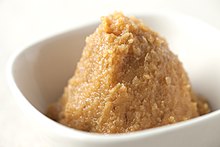**History and Evolution of Miso:**
– The origin of miso in Japan is not entirely clear, but grain and fish misos have been present since the Neolithic era.
– Miso is believed to have been introduced to Japan in the 6th century AD and its production evolved during the Edo period.
– Traditional homemade miso is becoming rare, leading to the emergence of new varieties.
**Ingredients and Varieties of Miso:**
– Ingredients for miso may include soybeans, barley, rice, etc., with fermentation time ranging from 5 days to several years.
– Japanese miso is classified by grain type, color, taste, and background, with specific regional variations.
– Different types of miso like kome, mugi, mame, and chōgō offer diverse flavors and characteristics.
**Chemical Properties and Nutritional Value of Miso:**
– The Maillard reaction is crucial for miso’s flavor, with volatile compounds giving it a unique aroma.
– Miso is rich in energy, protein, amino acids, vitamins (B1, B2, B3, A, E, K), and minerals (calcium, iron, zinc).
– It contains dietary fiber, is low in saturated fat, but has a high sodium content.
**Fermentation Process and Koji Production:**
– Miso’s unique properties and flavor come from compounds produced during fermentation.
– Ingredients for miso include a starter culture called koji, soybeans, and grains like rice, barley, or rye.
– Aspergillus oryzae mold is used to produce koji, which is essential for miso production.
**Usage, Storage, and Health Benefits of Miso:**
– Miso is a staple in Japanese cuisine, used in dishes like miso soup, miso-udon, and miso-glazed treats.
– Miso paste should be refrigerated after opening, and overcooking can kill beneficial microorganisms.
– Studies suggest miso may have health benefits, including potential effects on blood pressure and gut health.
Miso (みそ or 味噌) is a traditional Japanese seasoning. It is a thick paste produced by fermenting soybeans with salt and kōji (the fungus Aspergillus oryzae) and sometimes rice, barley, seaweed, or other ingredients. It is used for sauces and spreads, pickling vegetables, fish, or meats, and mixing with dashi soup stock to serve as miso soup, a Japanese culinary staple. Miso is high in protein and rich in vitamins and minerals, and it played an important nutritional role in feudal Japan. Miso is still widely used in both traditional and modern cooking in Japan and has been gaining worldwide interest.
 Miso | |
| Alternative names | Soybean paste, 味噌 (Japanese) |
|---|---|
| Type | Seasoning |
| Place of origin | Japan |
| Associated cuisine | Japanese |
| Main ingredients | Fermented soybeans, salt, kōji (Aspergillus oryzae) |


| Nutritional value per 100 g (3.5 oz) | |
|---|---|
| Energy | 831 kJ (199 kcal) |
26.47 | |
| Sugars | 6.2 |
| Dietary fiber | 5.4 |
6.01 | |
| Saturated | 1.139 |
| Monounsaturated | 1.242 |
| Polyunsaturated | 3.204 |
11.69 | |
| Tryptophan | 0.155 g |
| Threonine | 0.479 g |
| Isoleucine | 0.508 g |
| Leucine | 0.82 g |
| Lysine | 0.478 g |
| Methionine | 0.129 g |
| Cystine | 0 g |
| Phenylalanine | 0.486 g |
| Tyrosine | 0.352 g |
| Valine | 0.547 g |
| Arginine | 0.784 g |
| Histidine | 0.243 g |
| Alanine | 0.5 g |
| Aspartic acid | 1.171 g |
| Glutamic acid | 1.915 g |
| Glycine | 0.447 g |
| Proline | 0.619 g |
| Serine | 0.601 g |
| Vitamins | Quantity %DV† |
| Vitamin A equiv. | 0% 4 μg0% 52 μg0 μg |
| Thiamine (B1) | 8% 0.098 mg |
| Riboflavin (B2) | 18% 0.233 mg |
| Niacin (B3) | 6% 0.906 mg |
| Pantothenic acid (B5) | 7% 0.337 mg |
| Vitamin B6 | 12% 0.199 mg |
| Folate (B9) | 5% 19 μg |
| Vitamin B12 | 3% 0.08 μg |
| Choline | 13% 72.2 mg |
| Vitamin C | 0% 0 mg |
| Vitamin D | 0% 0 IU |
| Vitamin E | 0% 0.01 mg |
| Vitamin K | 24% 29.3 μg |
| Minerals | Quantity %DV† |
| Calcium | 4% 57 mg |
| Iron | 14% 2.49 mg |
| Magnesium | 11% 48 mg |
| Manganese | 37% 0.859 mg |
| Phosphorus | 13% 159 mg |
| Potassium | 7% 210 mg |
| Sodium | 162% 3728 mg |
| Zinc | 23% 2.56 mg |
| Other constituents | Quantity |
| Water | 50 |
| Alcohol (ethanol) | 0 |
| †Percentages estimated using US recommendations for adults, except for potassium, which is estimated based on expert recommendation from the National Academies. | |
Typically, miso is salty, but its flavor and aroma depend on the ingredients and fermentation process. Different varieties of miso have been described as salty, sweet, earthy, fruity, and savory.
